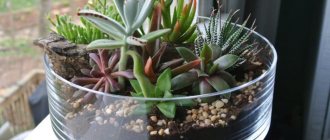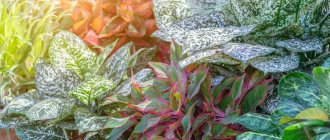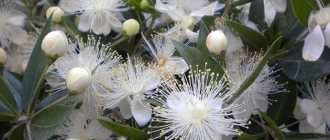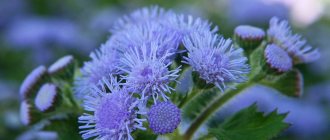Camellia photo Camellia (Camellia) is native to the Philippines and grows in the Asian tropics and subtropics as an evergreen shrub or small tree.. In indoor living spaces, offices and halls it is grown as an ornamental foliage, beautifully flowering plant. The height of a bush can vary from 50 cm and above, or a tree - from 1 to 3 m.
Camellia leaf blades are leathery, dense, bare, shiny, dark green in color, attached to short petioles one at a time or 2-3. They are ovoid, elliptical, wide, pointed or round in shape. The length of the leaves is from 6 to 8 cm. Spectacular camellia flowers with many stamens are painted in various colors, sometimes very variegated.
Also see how to grow gloriosa and camellia.
| Average growth rate |
| Abundant flowering from November to March. |
| The plant requires good care - acidic soil, cool conditions, high humidity. |
| Perennial |
Botanical description
Camellias are medium-sized, evergreen, tree-like shrubs. They belong to the Tea family. Distributed in Japan, China, Korea, and the Philippines.
Camellias grow well in humid climates, in mountainous areas and are not afraid of short frosts down to -15°C.
In this case, the acceptable summer temperature should not exceed +25°C .
In other cases, it is grown as a houseplant. The leaves of the plant are simple oval in shape, strong and glossy. The flowers resemble roses or peonies. In most species, the flowers have no scent. Large, double flowers are arranged singly on the branches. Color range from white to red. An amazing feature of camellia is its long flowering period when dormant.
It begins to grow actively after flowering ends. This process begins in March - April.
Mistakes of novice gardeners
- Camellia sheds its leaves - very dry soil. Watering time is determined by the condition of the soil; if the soil has dried out by 5 cm, then the plant needs moisture.
- The leaf blade becomes brown, and unopened buds fall off - the shrub is overflowing. In this case, the plant is transplanted into a new substrate.
- The leaves turn brown due to sunburn. The flower grows best on the east or west side.
A capricious plant - camellia
Camellia is an ornamental plant with a long flowering period. It will perfectly complement both your home interior and will be indispensable in landscape decor. In order for a shrub to delight with its flowering, it is necessary to surround it with care and love.
Varieties and photos
Currently, about 200 species are known. Let's look at the most popular ones. Below are photos, names and descriptions of camellia varieties suitable for propagation and care at home:
Mountain
It is a shrub up to 5 m in height. It blooms with flowers up to 7 cm in diameter. Flowering from November to January. The color of the flowers, depending on the variety, is white, pink and red. Flowering is very long : from November to January. When grown indoors, camellia growth is easily regulated by pruning branches.
Among the best varieties of mountain camellia are: “White Double” with double, white buds and “Inishi” with pink flowers, strong double buds. The photo below shows Camellia Mountain:
Chinese
Chinese camellia or Chinese tea rose loves air temperatures from +18°C to +25°C. In winter, the optimal temperature is +10°C. This unpretentious plant can withstand frosts down to -22°C. Excellent for shaping and decorating the crown. Chinese camellia blooms from August to October. Unlike other species, the Chinese “beauty” blooms with fragrant flowers. The flowers are white or yellowish in color.
Green tea is made from camellia chinensis. I widely use it in oriental and folk medicine. Camellia sinensis leaves have bactericidal properties.
Japanese
Japanese camellia is a tree-like shrub that in natural conditions grows up to 10 meters in height. Blooms from November to May , with double and semi-double flowers up to 5 cm in diameter. Japanese camellia can be grown both outdoors and indoors or in greenhouses. The leaves are oval-shaped, quite large: they can reach 10 cm in length. Dense and leathery, with a glossy surface, the leaves have a very decorative appearance.
Selected varieties of Japanese camellia can have not only monochromatic, but also variegated flower colors. In addition, some varieties have flowers collected in inflorescences.
The variety “Alba” is distinguished, blooming with white, simple buds; “Winter Rose”, the flowers of which are white or pink and are double; "Buttermint" with white flowers; "Lavinia Maggie" with variegated flowers. You can see what the Camellia Japonica variety looks like in the photo below:
Lady Campbell
'Lady Campbell' is a Japanese species of camellia. The compact bush grows up to 2 meters. The flowers reach 10 cm in diameter, the colors are scarlet with a pink tint. Long flowering from August to November . In the southern regions it can be grown not only as an indoor plant, but also in open ground. In regions with harsh winters it is grown as a pot plant. In the photo below is the Camellia Lady Campbell variety:
Temperature
Maintaining a suitable temperature regime is the key to lush camellia flowering. In spring and summer, the flower feels comfortable at 20-25 degrees.
The room in which the camellia is located must be well ventilated. However, you should know that the plant is very afraid of drafts and sudden temperature changes.
Starting in August, the temperature should be gradually reduced so that by mid-November it is in the range of 5-9 degrees. Such conditions are necessary for the proper formation and maturation of flower buds. From January, when flowering begins, the temperature rises to 10-15 degrees.
In summer, camellia can be taken out into the fresh air: into the garden or onto the balcony . It is important to ensure that it is protected from direct sunlight and drafts.
Relatively low air temperatures in winter are very important for flowering. If the thermometer rises above 13-15 degrees, there is a high probability that the buds will fall off. Therefore, in winter it will most likely not be possible to wait for flowers in a heated apartment. The most optimal place for winter maintenance is an insulated balcony or glazed loggia.
How to care?
Like any plant, camellia needs quality care at home.
Lighting
In nature, camellias grow in the undergrowth, which means they require diffused sunlight. For successful cultivation, it needs to create conditions similar to natural ones.
Temperature
Camellias overwinter at low positive temperatures from 0 to +5°C. In summer they prefer humid air heated to +25°C. During the flowering period, a temperature of no higher than 12-15 degrees Celsius is required. And after flowering, during the period of active growth, keep the temperature within +20°C. From July to August, camellia begins to lay buds, at which time it needs heat no more than +25°C.
Direct sunlight may cause dry, brown spots to appear on camellia leaves.
Humidity and watering
During flowering, water in small quantities.
This is due to the fact that camellia blooms at rest. And it doesn't require a lot of moisture. After flowering has ended, watering is increased, as the camellia begins to actively grow. At this time, the earthen coma should not be allowed to dry out . During the period of bud formation, moderate watering is needed. This is done in order to improve the quality of the buds.
From excessive watering, camellia leaves develop brown spots and swellings.
For irrigation you need to use soft or rain water. Or ordinary water, which has been left for at least three days with the addition of a few drops of lemon juice.
Top dressing
Complex formulations for azaleas are used for feeding and fertilizing. In winter, the flower does not need feeding. Fertilizers should be applied during the period of active growth. It is enough to fertilize camellia twice a month.
Transfer
Camellia is transplanted during the dormant period or in the flowering state. The best time is late February - early March . The container for replanting should be no more than 1-2 cm in diameter larger than the previous one. Before planting the bush in a new pot, you need to carefully straighten the roots. This is done for better rooting and growth.
A flower pot or other container for planting must have drainage holes. A drainage 2-3 cm thick is laid at the bottom. Expanded clay, broken clay or ceramic shards are used as drainage.
Additionally, you need to sprinkle a small layer of coarse river sand on top. Plastic flower pots are great for camellias because they do not evaporate moisture. There should be only one drainage hole in the container.
What kind of land is needed?
Camellia prefers light, acidic soils.
Soil acidity is from 4-5.5 ph. A ready-made soil substrate for azaleas and rhododendron mixed with rotted pine needles is well suited. When planting, you need to pay special attention to the root collar of the plant. It cannot be buried in the ground.
Trimming
Growing in open ground, do not need pruning. Unless the owner of the plant decides to give the shrub a more decorative appearance. Camellias are great for crown formation.
If the bush grows in a pot and gains a lot of green mass, it becomes difficult for the roots to support the entire plant and this may affect the quality of flowering. In this case, it is recommended to prune the plant and give it the opportunity for abundant and lush flowering.
Pruning is carried out after the end of growth from the end of June.
Transfer
Camellias are replanted not in February-March, like other indoor flowers, but in late autumn or winter. She begins a period of rest, coinciding with flowering. Therefore, you can replant a flowering plant, being careful. Young plants need to be replanted every year. Large bushes can be replanted by transshipment once every two to three years, when the roots fill the entire volume of the pot.
In preparation for transplanting (planting), it is necessary to prepare a wide pot, at the bottom of which a layer of drainage is poured. You can buy land ready for azaleas and camellias. Since different manufacturers allow deviations in the composition, when purchasing a ready-made earthen mixture, you should pay attention to the presence of the following components in the soil:
- peat;
- sand;
- leaf soil;
- vermiculite.
You can prepare the mixture yourself by mixing peat, sand, leaf and coniferous soil. All ingredients are taken in equal parts, and sand - half as much. The soil must be loose to prevent stagnation of water. Soil acidity should be between 4.0–5.5 units. To increase its permeability, it is recommended to add ground coniferous tree bark. Its pieces are usually sold for planting orchids.
This may be interesting: Medinilla varieties are favorites among flowering ones
When replanting a flower, you should pay special attention to the root collar, which should not be covered with soil, but be at ground level. When transferring an adult plant to a larger pot, add fresh mixture. If it is necessary to increase the acidity of the soil, mulch it on top with sawdust or small pieces of bark.
Reproduction
Gardeners have many questions about propagating camellias at home. There's really nothing complicated. Let's look at methods that even novice plant growers can handle.
Cuttings
Cuttings are carried out from June, when the camellia growth period is over, the shoots have matured and become half lignified. Take cuttings with 4-5 leaves . Remove the lowest leaf and make an oblique cut under the node. The remaining leaves can be cut in half to reduce evaporation.
The cut of the cutting must be treated with “Kornevin” and placed in a container with river sand or river sand mixed with peat.
For better rooting of cuttings, high humidity is needed. To achieve this, you need to place the cutting together with the container under a plastic cap or make a structure from polyethylene. For rooting, cuttings are placed in a warm place with an air temperature of 20-25°C. The rooting process of camellia is very long and takes more than 2 months. But at the same time, this method of propagation will preserve the variety of the plant.
From seeds
The seed method of camellia propagation takes a very long time. A plant grown from a seed will begin to bloom only in its fifth year. Propagation by seeds does not guarantee the preservation of the maternal characteristics of the variety.
Expert opinion
Vera Ivanovna Sh
Since childhood, I have been interested in growing indoor flowers, then I decided to devote my life to landscape design and gardening.
Camellia seeds are sown immediately after ripening, before winter. Once the seed pod has opened, the seeds are ready for sowing. They are sown in a mixture of river sand and peat. And put in a warm place up to +25°C. After the sprout appears, the container is moved to a shaded place while maintaining the temperature regime. When the sprouts reach 7-10 cm, they can be transplanted into a pot with a larger diameter. The composition of the soil remains the same.
If the seeds were purchased in a store, they should be stored in the refrigerator until planting. Before planting , the seeds are soaked for several days. And then, since the seed shell is very hard, you need to make a hole in it to speed up the germination of the plant.
Offspring
The easiest way to propagate Camellia is by root suckers. As the mature plant grows, it may develop side shoots. When they reach acceptable growth, they are carefully separated from the mother root and planted in a separate pot. Then they grow and care for them in accordance with the requirements.
Vaccination
Experienced gardeners propagate camellia by grafting. This method is used to propagate selected varieties that are difficult to propagate by seeds and cuttings.
For the grafting method, you need to take sprouted sprouts of at least 5 cm. The top of the sprout is cut off and split. A pre-prepared camellia cutting is inserted into the cut site and needs to be rooted.
The sprout is planted in a mixture of peat and river sand . The pot is placed in a plastic bag and ventilated as condensation accumulates. The place should be warm and dark. There should be no drafts or direct sunlight. The grafting site is wrapped so that the cutting does not fall out or move. It is best to use some kind of breathable material, gauze or cotton strip. And secure the bandage on top with an adhesive plaster. But under no circumstances should adhesive tape or tape be used.
The graft should not be unwound often for inspection, as there is a risk of damaging it. The first examination can be carried out after 2-3 months. And the bandage can be completely removed no earlier than after 6-8 months.
Whether the graft has taken root or not will be clearly visible from the state of the sprout. If at first it is weak, perhaps completely shedding its leaves, then as the grafting takes root, the appearance of the plant will improve.
The grafting method is quite complicated for beginners. But it makes it possible to combine the advantages of seed and cutting methods of camellia propagation. When grown from seed, it takes a long time before the bush begins to bloom. And cuttings do not give a high percentage of rooting, but there is a guarantee of the safety of the variety. By combining these two methods, you can achieve success in reproduction.
Problems
- Camellia may lose leaves due to insufficient or excessive watering;
- The leaves begin to turn brown and the buds fall off as a result of acidification of the soil;
- Brown spots on the leaves indicate sunburn;
- Dropping buds may indicate a lack of nutrients or inadequate soil acidity.
- Falling buds may also indicate excessive watering and, accordingly, acidification of the soil. Also, camellia can shed buds if it is moved from place to place during their formation.
- Black spots on leaf blades may indicate that the ambient humidity is too low. In this case, damaged leaves should be removed and healthy leaves should be wiped with a damp foam sponge.
Diseases and pests
Indoor camellias are susceptible to diseases and pest attacks. The main measure to prevent disease is to keep it away from other plants. And strict adherence to care rules.
Why do the leaves turn black?
Camellia leaves turn black as a result of excessive soil moisture. This plant does not like stagnant moisture. Therefore, it needs to be watered when the top soil dries 2-3 cm. If, nevertheless, the plant was flooded and the leaves began to turn black, the following measures should be taken:
- Trim affected branches back to healthy matter.
- Transplant into another container, changing the drainage and soil.
- When replanting, inspect the root system and remove damaged roots. They will be dark in color.
Also, the causes of darkening of the leaves may be a disease. For example, phyllostictyosis. In case of fungal diseases, you need to remove the affected areas of the plant and treat the bush with a solution of “Bordeaux mixture” or “copper sulfate”.
Why do the leaves fall?
Camellia can shed its leaves if it is stressed.
Flooding the soil with water, a draft, moving it to a new place, drying out the earthen coma, lack of lighting - all these reasons can lead to the loss of leaves and shedding of buds. To help the plant, you need to create optimal conditions for it to grow. It may be necessary to fertilize with mineral fertilizers . It is best to use complex fertilizers for azaleas.
You can try a home remedy, such as using dried and crushed banana peels and eggshells to feed the plant.
Spider mite
Dry air and too warm temperatures cause spider mites to appear. To combat this pest, oil aerosols are used. Or you can use a soap solution if the plant is not severely affected. Prepare a solution from soft water and laundry soap. If there is a large number of pests, it is better to use Fitoferm preparations and others.
Mealybug
Mealybug larvae are easy to see on the plant. Damaged leaves are cut off along with the larvae. And the whole plant is treated with a solution of “karbofos”. Dilute the drug per 1 liter of water with 20-40 drops.
Fertilizer
Feeding camellias should be done from March to August once every 2-3 weeks.
For this purpose, you can use both mineral and organic fertilizers, with the exception of manure. Liquid fertilizers for azaleas or orchids will be effective.
You can read more about organic and mineral fertilizers here.
It is not recommended to use fertilizers containing calcium and magnesium to feed camellia, since the plant receives sufficient amounts of them with water. And their excess alkalizes the soil, which negatively affects the growth and development of the flower.
It is better to halve the dose indicated on the fertilizer packaging, since an excess of minerals is no less harmful to camellia than their absence.
Fertilizers should always be applied to moist soil so as not to burn the root system of the flower.
Photo gallery
Benefits of camellia oil
In Chinese traditional medicine, Camellia japonica is considered an anti-cancer plant, and its flowers are used as an astringent and tonic. Camellia japonica or tsubaki oil is also very popular. This component is very highly valued in cosmetology due to its unique composition, represented by a large number of antioxidants and fatty acids.
The natural product is indispensable in the care of any skin type and has softening and moisturizing properties. After use, the skin becomes smooth, elastic and velvety. Among other things, the oil can be used as a highly effective composition against ultraviolet radiation, helps smooth out wrinkles, helps relieve swelling and eliminates irritation. The oil is widely used to whiten and reduce pigmentation, eliminates darkening and bags under the eyes, helps even out skin tone and gives it a healthy glow.
Tsubaki oil has proven itself very well in hair care, helping to strengthen hair follicles, eliminating dryness, brittleness and fragility. After use, there is an improvement in hair structure and scalp condition.
Reviews about the oil are most often positive. Consumers of the product note that the product is transparent and thick, but very easily and well absorbed, and almost completely odorless. As a rule, high-quality oil has a weak herbaceous aroma and 100% natural composition. It is considered ideal to use it in combination with shea butter instead of a day cream, and good results can be obtained by adding the product to various clay-based masks.
Possible difficulties during cultivation
In the process of indoor cultivation of Japanese camellia, some difficulties may arise associated with:
- rotting of plant roots under the influence of black mold or root rot. Common signs of disease are: wilting of buds and leaves, unpleasant odor from the pot. The problem can be solved by timely replanting the plant, removing all diseased roots and completely changing the soil and pot;
- the appearance of scale insects on the leaves of the flower, the signs of which are dark tubercles on the back of the leaves. You can overcome scale insects by treating the plant with Fitoverm, according to the instructions;
- the appearance of mealybugs, which manifests itself as a white coating on the leaves. The flower must be treated with Karbofos, according to the instructions.
Growing Japanese camellia indoors is not easy, but by following the flower care recommendations, you can get a healthy and beautifully flowering plant that will definitely become the center of attention.











